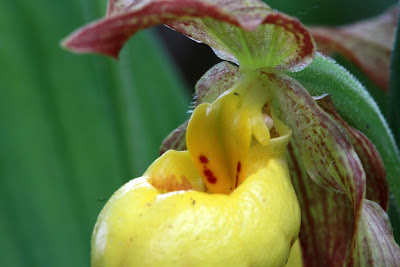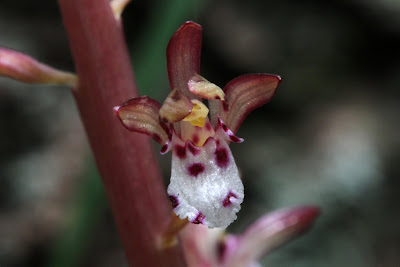This week on a trip to eastern Washington we revisited the site where we had found the beautiful mixed population of Mountain and Yellow Lady's Slippers, Cypripedium montanum, Cypripedium parviflorum var. makasin and their natural hybrid, Cypripedium x columbianum. We not only enjoyed them for a second time but went on to look for Lady's Slippers in two other locations. The first site was posted against trespassing and we were not able to search there, but at the second site we found Slippers, probably Cypripedium montanum, not yet in bloom.
Cypripedium parviflorum var. makasin
Cypripedium x columbianum
Cypripedium montanum var. welchii
We also had opportunity to see the Eastern Fairy Slipper, Calypso bulbosa var. americana. It is different from the western variety, var. occidentalis, in three ways, it has a yellow beard on the lip where the Western Fairy Slipper has a white beard, it lacks the brown spotting on the end of the lip that the western variety has, and it blooms later. This variety is found all across Canada and the northern United States, while the western variety is found only in Alaska, Washington, Oregon, Idaho, California and British Columbia.
Calypso bulbosa var. american fma. rosea
The majority of the Fairy Slippers were the all-pink variety, Calypso bulbosa var. americana fma. rosea. Whether these bloom a little later than the white variety of which we found only a few, or whether they are almost all the pink form in this location, I do not know. We looked for the all-white variety and for the natural hybrid between the eastern and western varieties but found neither. It was a delight to see these Fairy Slippers, however since we do not see them on our side of the mountains.
Later in the week I made a brief trip to a number of places on Whidbey and Fidalgo Islands and found five different Coralroots in bloom. At one location it was the pale form of the Western Coralroot, Corallorhiza mertensiana fma. pallida, that was blooming. I not only photographed some of the different color forms but found two plants of a near-alba form. The alba form is fma. albolabia, yellow with a completely white lip, but these were not quite that since they had some purple color in the lip.
At several sites I found the Spotted Coralroot blooming, either the ordinary variety, Corallorhiza maculata var. maculata, or the western variety, Corallorhiza maculata var. occidentalis, and some different color forms in each variety. These are distinguished by the shape of the lip, bloom time and flower shape. The ordinary variety has a lip with more or less parallel sides, a later bloom time, and flowers that are quite cupped. The western variety has a rounded lip and an earlier bloom time.
Corallorhiza maculata var. occidentalis
Corallorhiza maculata var. maculata
At one of the same sites as I found the Spotted Coralroot I also found the Ozette Coralroot, another variety of the Spotted Coralroot, Corallorhiza maculata var. ozettensis. This variety is quite rare, found only in a few locations in Washington and British Columbia, and blooms in the location where I saw it along with and alongside the Spotted Coralroot, Corallorhiza maculata var. maculata. It is worth traveling some distance to see since it is very different from the other varieties, though obviously a Coralroot.
The most unusual find of the day was growing with the Ozette Coralroots and appears to be a hybrid or intermediate form between the Western Coralroot and the Ozette Coralroot. At first glance it appears to be the Ozette Coralroot itself since the distinctive stem and flower color and lip shape are the same, but both flowers and lip are spotted. It was also growing in and among the Ozettes in the places I found it. I had found a stem or two previous years but this year there were many of them.
These would probably still be classified as Corallorhiza maculata var. maculata, but they do not look like any I've ever seen and their visible similarity to the Ozette Coralroots is striking. I am making efforts to contact the man who originally described the Ozette Coralroots in order to get his thoughts on this interesting plants.
























































14 comments:
Piękne storczyki są w Twoich stronach . Bardzo dobre zdjęcia!
Obrigada pelas preciosidades que sempre compartilha.
abraços
it will be interesting to her what the professor has to say about the hybrid possible
Thanks for your comments my friend. I'm on my way to your blog to see what you've been up to and what you've found.
Thanks once again for commenting, Elisabete. Wish sometime I could see some of your native orchids in their natural settings.
It was really odd, Marti, to see these plants, which looked exactly like the Ozettes from a distance, and find that they were spotted. All the Spotted Coralroots growing there are very different.
Wow! What a set!
That Fairyslipper is a beauty. I think that ssp. americana is the nicest. At least as far as I can tell from pictures that is. The one's I found in sweden were mostly white lipped, but there also at least one with a pink lip. However I do not know if that is special for the european variant. Interesting to see how different the subspecies really are.
It is a pleasure to see the different coralroots too, especially since I missed Corallorhiza trifida. Maybe I get a second chance in the German and Austrian Alps, tho our aim is to find Nigritella species there.
Nice pictures of te lady slippers too. I bet it was quite te display. We have only one species. This year I missed it in Germany, but saw it in Estonia by the roadside from the car.
Thanks for the nice pictures and the articles. I enjoy those a lot.
Yes, that was quite a week, Martin. The Fairy Slipper we had seen in British Columbia, but not here in Washington and the same for the Yellow Lady's Slipper, but the mixed population was really something to see with what were obviously natural hybrid between the two species.
We want to go back to the place where we saw the Fairy Slippers next year to look for the natural hybrid between the two varieties. It's very rare but has been seen in that location and I'm determined to find it. We were a little late this year.
We were out this week again to a site where there are several hundred Mountain Lady's Slippers and to another place that has Phantom Orchids by the thousands as well as some really unusual Coralroots.
I love Cephalenthera. Seeing the phantom orchid must be quite the experience. All this with Coralroots... such a tease :-)
It seems our 3 Cephanlenthera species are not that rare as yours. C. rubra should be starting now. C. damasonium and C. longifolia are done for this year however. I did not make many pictures worth showing this year however.
The Phantom Orchid is amazing. I can remember seeing it for the first time on a very dark forest floor where nothing else was growing and the bone-white plants stood out in the dim light like phantoms. Because it's mycotrophic, of course, it doesn't need much light, though the plants that we saw this week are in a more open area. They were everywhere.
Wonderful! I'm proud to have you as a member in our group!
So long!
Klaus Ehrenheim
Thanks, Klaus. Appreciate very much your kindness.
Quite a display of one beauty after another. It was a feast to see the variety and see the subtle differences between those which are similar. Nice info of the trip as well. As always, Ron, enjoyable
Missed this, Beatriz. Thanks for the kind comments.
Post a Comment